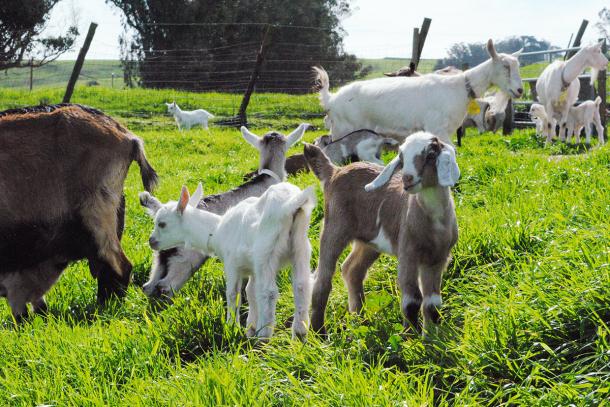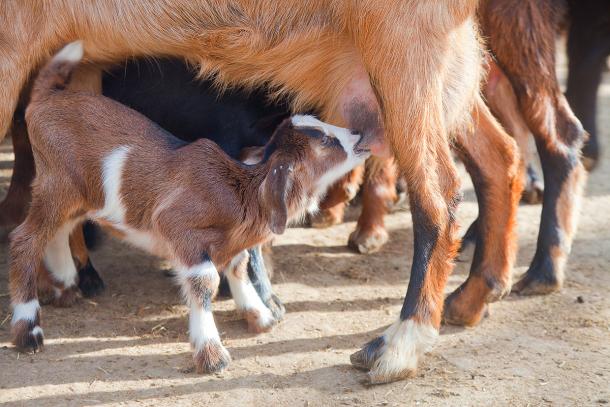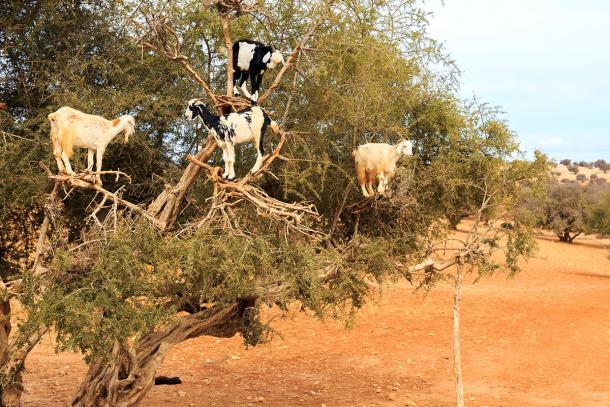11 Reasons to Go(at) Crazy for Goats
April 11, 2019

Goats will be taking over the Ferry Plaza Farmers Market tomorrow, April 13, for CUESA’s Goat Festival, another fun-filled day of petting, enjoying, and discovering all things goat. (In case you’ve missed this epic festival in the past, here’s what you might expect.)
Goats are widely known for jumping exuberantly, fainting spontaneously, and yelling like humans on occasion, but there are many more reasons to enjoy these adorable ungulates. For example, they are naturally curious, they’re light on the earth, and they bring us goat cheese.
In anticipation of CUESA’s tenth annual Goat Festival, here are 11 reasons to go(at) crazy for goats.

1. It takes 10 goats to produce the milk of one cow, but 10 goats are better for the environment, since they eat less food and emit less methane gas than cows. Because of their small size, they can even be raised in residential areas, and their dry, pelletized droppings provide a clean, odorless, and nutrient-rich natural fertilizer.
2. Goats are one of earliest animals to be domesticated by humans. Archaeological records suggest that farmers in the Middle East began raising goats 10,000 to 11,000 years ago. Today, the vast majority of the world’s domesticated goats live in Africa and Asia.
3. Goats are generally raised for dairy, meat, and fiber. Under USDA guidelines, growth hormones are not approved for use in goats. Antibiotics are used rarely, and only as needed to prevent or treat diseases. Goat meat is a lean and heart-healthy source of protein, with lower fat, fewer calories, and less cholesterol than both beef and chicken.

4. Contrary to popular belief, goats do not dine on tin cans. However, they are eco-friendly brush-clearing power eaters. Like cattle, sheep, and other ruminants, the goat has a four-compartment stomach, but goats are browsers, not grazers, meaning they prefer shrubs and other woody plants to grass. They will gobble up difficult invasives like poison ivy and blackberry brambles, making goats a nimble and sustainable alternative to herbicides and gas-powered mowers for fire prevention and weed control. They are especially adept at clearing hard-to-reach places like hillsides and ditches. Through City Grazing in San Francisco, goats are used for landscaping and fire prevention.
5. Popular dairy breeds include Alpine, La Mancha (tiny ears), Oberhasli, Nubian (long ears), Saanen (white), Sable, and Toggenburg. Boer is the most common meat breed. Angora goats are raised for mohair, a silk-like fiber used in yarn. Many goats produce a downy winter undercoat known as cashmere, though only certain breeds produce enough to be raised for commercial fiber production.

6. Female goats have two teats, in contrast to cows, which have four. Nannies typically give birth to twins, with single kids, triplets, and larger litters being less common. The mothers produce an average of one gallon of milk a day, the highest yield of milk for their body size among dairy animals. A female goat is called a “doe” or “nanny,” and a male goat is called a “buck” or a “billy.” Babies are called “kids.”
7. Goat milk consumption is on the rise in the U.S. The fat content of goat’s milk is similar to cow’s milk, but goat’s milk has smaller fat globules, which means the cream doesn’t separate and rise to the top, and therefore the milk doesn’t need to be homogenized. The distinctly “goaty” flavor of the milk and cheese is due to the presence of fatty acids like caproic, caprylic, and capric acid, which take their names after goats (Latin caper).
8. Some people who have sensitivities to cow’s milk are able to enjoy goat dairy. It has roughly the same amount of lactose as cow’s milk but contains only trace amounts of the allergenic casein protein alpha S1 and it has smaller butterfat particles, making it easier to digest. Goat’s milk can be consumed straight or made into cheese, ice cream, yogurt, kefir, confections, soaps, and event paint.
9. Goats are all-seeing! Researchers have found that those uncanny rectangular pupils actually give goats and other grazing animals a wider range of vision than their predators. A goat’s eyes can rotate up to 50 degrees so that that they can remain vigilant while bending over to eat.
10. Goats are notoriously agile climbers. In Morocco, goats climb argan trees to get at their fruit. They have also been known to climb donkeys. Mountain goats, despite their name, are more closely related to antelopes and gazelles than domesticated goats.
11. Backyard goats are legal in San Francisco. According to the San Francisco Health Code, two female goats may be kept for “exclusive use of the owner’s family.” You can get the lowdown on urban goat-keeping from Itty Bitty Farm in the City. Get your goat!

Photos of goats sticking out tongue, eating, nursing, and climbing from depositphotos.com.
Topics: Animal welfare, Celebrations
